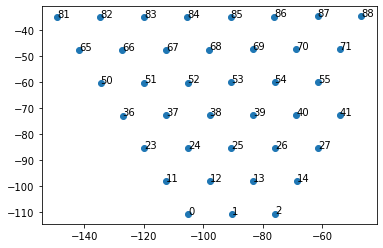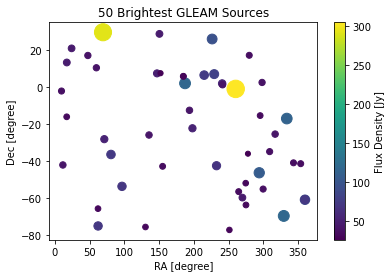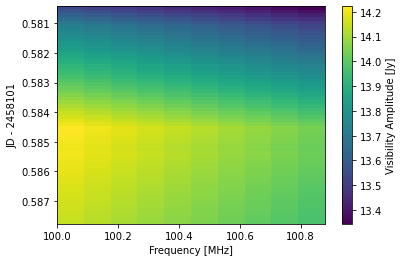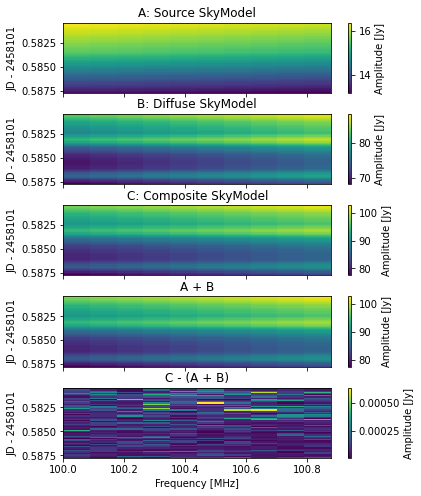Visibility Simulator Examples¶
Although hera_sim is primarily aimed at simulating instrumental effects on top of existing visibility data, the package also has the visibilities module that offers a uniform visibility simulation interface to wrappers for several visibility simulators, as well as a few analytic beam models of the HERA antenna.
Visibility Simulation Interface¶
Starting from versions of hera_sim >= 2.0.0, wrappers for VisCPU, healvis, and pyuvsim visibility simulators are provided through the VisCPU, Healvis, and UVSim classes.
The new ModelData object serves as a container for the visiblity data and all information required to perform visibility simulation. A preferred method to initialize this object is to use the classmethod from_config, providing pyuvsim configuration files that specify the observation and telescope parameters, beam model, and sky model. Direct initialization is also supported and currently required to utilize analytic HERA
beam models in the hera_sim.beams module (see Manual Initialization). Under the hood, ModelData wraps three objects used for facilitating simulation in pyuvsim, each encapsulating different information required for simulating visibility. * pyuvdata.UVData * A data container for observation parameters, array layout, telescope location, and visibility. * Accesible from the uvdata property. * Package reference:
https://pyuvdata.readthedocs.io/en/latest/index.html * pyradiosky.SkyModel * A data container for sky models, including catalog of sources and diffuse sky maps in HEALPix. * Provide methods for conversion from a catalog of point sources to a HEALPix map and vice versa, which is used by the visibility simulator wrappers. * Accesible from the sky_model property. * Package reference: https://pyradiosky.readthedocs.io/en/latest/index.html * pyuvsim.BeamList and the associated
beam_ids * Specify the antenna beam models and which beam model each antenna uses. (See Manual Initialization for supported beam types.) * Accesible from the beams and beam_ids properties. * Reference: https://pyuvsim.readthedocs.io/en/latest/classes.html#pyuvsim.BeamList
The VisibilitySimulation class is the new uniform visibility simulation interface. It takes an instance of a VisibilitySimulator class (of which VisCPU, HealVis and UVSim are examples) and a ModelData object as inputs. Visibility simulation can then be executed simply by calling the simulate method on an instance of a VisibilitySimulation class. This returns a Numpy array of visibilities in the same shape as in the UVData.data_array specification, which is
also added to the object property VisibilitySimulation.data_model.uvdata.data_array.
The motivation behind the VisibilitySimulation-VisibilitySimulator-ModelData setup is to provide a single uniform interface to many simulators, and the ability to create wrappers for simulators that are not already provided. This interface is heavily based on the pyuvsim configuration specifications and infrastructures, and thus it provides the ability to perform simulation with any simulator given the same static configuration.
Example 1: Demonstrate the Uniform Visibility Simulator Interface¶
[1]:
"""This example simulates visiblities with VisCPU at 10 frequencies and 60
times with the 50 brightest GLEAM sources as a sky model and the HERA Phase I
array as the instrument."""
from hera_sim import DATA_PATH
from hera_sim.visibilities import VisCPU, ModelData, VisibilitySimulation
# Path to the example pyuvsim configuration files.
# These can be found in `hera_sim.DATA_PATH` to follow along.
config_file = (
DATA_PATH /
'tutorials_data/visibility_simulator/obsparam_hera_phase1_gleam_top50.yaml'
).as_posix()
# Initialize a ModelData object.
# The pyuvsim configuration files consist of a few yaml and csv files, and a
# sky model file readable by `pyradiosky`. `ModelData.from_config` takes the
# outermost file obsparam_*.yaml as an input.
data_model = ModelData.from_config(config_file)
# Initialize a VisCPU simulator.
simulator = VisCPU()
# simulator = VisCPU(use_pixel_beams=False)
# simulator = UVSim(quiet=True)
# Construct a VisibilitySimulation object.
simulation = VisibilitySimulation(data_model=data_model, simulator=simulator)
# Executing the simulation by calling `simulate` method.
visibility_array = simulation.simulate()
Accessing Simulation Parameters and Visibility¶
All simulation parameters and visibility data are contained in the ModelData object and can be retrieved from the corresponding object attributes and properties.
Example 2: Plot the array layout of the simulation in Example 1¶
[2]:
import matplotlib.pyplot as plt
from pyuvdata import utils as uvutils
uvd = simulation.data_model.uvdata
# Get antennas positions and corresponding antenna numbers
antpos, antnum = uvd.get_ENU_antpos()
# Plot the EN antenna position.
plt.scatter(antpos[:, 0], antpos[:, 1])
for i, antnum in enumerate(uvd.antenna_numbers):
plt.text(antpos[i, 0], antpos[i, 1], antnum)
plt.show()

Example 3: Plot the source positions in the SkyModel used in Example 1¶
[3]:
sky_model = simulation.data_model.sky_model
print('Type of sky model:', sky_model.component_type)
print('Number of sources:', sky_model.Ncomponents)
# Extract the source positions and fluxes
ra = sky_model.ra
dec = sky_model.dec
flux = sky_model.stokes[0, 0, :]
# Plot the source positions with color and size showing source fluxes.
plt.scatter(ra, dec, s=flux, c=flux)
plt.colorbar(label='Flux Density [Jy]')
plt.xlabel('RA [degree]')
plt.ylabel('Dec [degree]')
plt.title('50 Brightest GLEAM Sources')
plt.show()
Type of sky model: point
Number of sources: 50

Example 4: Plot the waterfall of the visibility simulation in Example 1¶
[4]:
import numpy as np
bls = (0, 1, 'xx')
waterfall = uvd.get_data(bls)
extent = [uvd.freq_array[0, 0] / 1e6, uvd.freq_array[0, -1] / 1e6,
uvd.time_array[-1] - 2458101, uvd.time_array[0] - 2458101]
plt.imshow(np.abs(waterfall), aspect='auto', interpolation='none',
extent=extent)
plt.xlabel('Frequency [MHz]')
plt.ylabel('JD - 2458101')
plt.colorbar(label=f'Visibility Amplitude [{uvd.vis_units}]')
plt.show()

For more comprehensive visualization of visibility data (e.g. waterfalls of differences between visibilities, Fourier Transform of a waterfall, and etc), users may be interested in plotting routines in the HERA uvtools package.
Initializing Model Data¶
As mentioned, the ModelData object contains all the data and information required to perform visibility simulation with hera_sim.
The prefered method to initlize a ModelData object is to generate a set pyuvsim configuration files (see https://pyuvsim.readthedocs.io/en/latest/parameter_files.html) and then pass the top-level obsparams_*.yaml file to the classmethod from_config.
data_model = ModelData.from_config(config_file)
If not using configuration files, the underlying objects can be first created and passed to the ModelData constructor for manual initialization.
Users may consider using hera_sim.io.empty_uvdata, pyuvsim.simsetup.initialize_uvdata_from_params, or pyuvsim.simsetup.initialize_uvdata_from_keywords to construct a UVData object.
See the next section on how to construct a sky model with pyradiosky.SkyModel.
The beam models given to the beams parameter can be: i) a pyuvsim.BeamList object, ii) a pyuvdata.UVBeam, or iii) a list of pyuvsim.AnalyticBeam, including its subclasses.
The hera_sim.beams module provides analytic models of the HERA antenna through the PolyBeam, PerturbedPolayBeam, and ZernikeBeam objects (see HERA Memo #081 and #101, and Choudhuri et al 2021). Although these beam models are subclasses of
pyuvsim.AnalyticBeam, they are currently not regcogniziable by the pyuvsim configuration file parser, and thus can only be used by initializing ModelData manually.
Example 5: Manaully initialize a ModelData object with PolyBeam¶
[5]:
from pyuvsim.simsetup import initialize_uvdata_from_params, _complete_uvdata
from pyuvsim import BeamList
from pyradiosky import SkyModel
from hera_sim.beams import PolyBeam
# Initialize just the UVData and beam_ids from the pyuvsim configuraton files.
# The configuration file (same as in Example 1) uses the "airy" type
# `pyuvsim.AnalyticBeam` as the beam models. Here,
# `pyuvsim.simsetup.initialize_uvdata_from_param` returns `UVData`, `BeamList`,
# and `beam_ids`, but we will discard and replace the `BeamList` with a new
# `BeamList` that uses the `PolyBeam` model.
uvdata, _, beam_ids = initialize_uvdata_from_params(config_file)
# Fill `data_array` with zeros and commplete the UVData object.
_complete_uvdata(uvdata, inplace=True)
# Construct a new `BeamList` with polarized `PolyBeam`.
# `beam_coeffs` from Choudhuri et al 2020.
cfg_pol_beam = dict(
ref_freq=1e8,
spectral_index=-0.6975,
beam_coeffs=[
2.35088101e-01,
-4.20162599e-01,
2.99189140e-01,
-1.54189057e-01,
3.38651457e-02,
3.46936067e-02,
-4.98838130e-02,
3.23054464e-02,
-7.56006552e-03,
-7.24620596e-03,
7.99563166e-03,
-2.78125602e-03,
-8.19945835e-04,
1.13791191e-03,
-1.24301372e-04,
-3.74808752e-04,
1.93997376e-04,
-1.72012040e-05,
],
polarized=True,
)
beams = BeamList([PolyBeam(**cfg_pol_beam)])
# Load the SkyModel. Same model used in Example 1.
sky_model_file = (
DATA_PATH /
'tutorials_data/visibility_simulator/gleam_top50.skyh5'
).as_posix()
sky_model = SkyModel()
sky_model.read_skyh5(sky_model_file)
# Construct ModelData
data_model_polybeam = ModelData(
uvdata=uvdata,
sky_model=sky_model,
beam_ids=beam_ids,
beams = beams
)
Constructing a SkyModel¶
pyradiosky.SkyModel is both a container and an interface for representing astrophysical radio sources.
A SkyModel object will usually consist of many components that represent either compact point sources or pixels of a HEALPix map. This choice can be set by specifying component_type="point" or component_type="healpix" when constructing the object. Doing so will determine which parameters are required as followed. * If component_type="point", the name of each source and the source position (ra and dec) are required. * If component_type="healpix", the nside
parameter of the HEALPix map, the indices of the HEALPix pixel hpx_inds, and the HEALPix pixel ordering hpx_order must be set. * If component_type is not set, the type is infered from weather nside is given.
The component flux is given per frequency as an array of Stoke IQUV via the stokes argument (Shape: (4, Nfreqs, Ncomponents)). In addition, the spectral_type must be specified, which can be: * “flat” : Flat spectrum. * “full” : Flux is defined at each frequency given in the freq_array attribute. * “subband” : Flux is defined at a set of band centers give in the freq_array attribute. * “spectral_index” : Flux is defined at a reference frequency set in the
reference_frequency attribute and follows a power law given a spectral index set in the spectral_index attribute.
The method at_frequencies can be used to evaluate the stokes array of a SkyModel object at specified frequencies, converting the object to a “full” spectral type when inplace=True, or yielding a new instance of the object with a “full” spectral type if inplace=False.
The classmethods pyradiosky.from_gleam_catalog, pyradiosky.from_votable_catalog, and pyradiosky.from_text_catalog can be used to SkyModel object from the GLEAM EGC catalog file, a votable catalog file, or from a tab separated value file. The pyuvsim.simsetup.create_mock_catalog method can also be used to create a mock catalog of point source and/or diffuse sky
Loading a HEALPix map into a SkyModel object is currently only possible via the native skyh5 file format. Thus, a diffuse sky map in a HEALPix FITS format (e.g., Haslam 408 MHz) must be manually initialized from the HEALPix array values and indices.
A method for converting a SkyModel object from one component type to another is provided, which can be used to convert a “healpix” model to “point” and combine with another “point”-type model, for example. This conversion is used by hera_sim in its VisCPU and healvis wrappers.
Below, we show how to create a random point source model and a uniformly distrubuted diffuse model, and combine them into a single SkyModel object. Please refer to the pyradiosky developer API for details of the objects parameters and methods.
Example 6: Construct a random point source SkyModel¶
[6]:
from pyradiosky import SkyModel
from astropy.coordinates import Longitude, Latitude
from astropy import units as u
## Point Soruce Model ##
component_type = 'point'
# Each source is a component in a SkyModel.
# Create a sky model with 50 random sources (i.e. 50 point source components).
nsources = 100
# `ra` and `dec` must be Longitude and Latitude astropy quantity
ra = Longitude(np.random.uniform(0, 360, nsources) * u.degree)
dec = Latitude(np.random.uniform(-90, 90, nsources) * u.degree)
# `names` are required for point soruces
names = [f'rand{i:02d}' for i in range(nsources)]
# SkyModel supports several spectral type. We will use "spectral_index" here,
# where the flux of each source is describe by a power law given a reference
# frequency and a spectral index.
spectral_type = 'spectral_index'
spectral_index = np.random.uniform(-4, 3, nsources)
reference_frequency = 200e6 * np.ones(nsources) * u.Hz
# Source fluxes must be given in Stokes IQUV as an array of astropy quantity
# with an appropriate unit. Shape (4, Nfreqs, Ncomponents).
# Nfreqs is 1 here because we are using "spctral_index".
stokes = np.zeros((4, 1, nsources)) * u.Jy
stokes[0, :, :] = np.random.uniform(10, 100, nsources) * u.Jy
# Let's also give our sources ~10% linar polarization
stokes[1, :, :] = np.random.uniform(1, 5, nsources) * u.Jy
stokes[2, :, :] = np.random.uniform(1, 5, nsources) * u.Jy
# Collect all parameters in a dictionary to be passed to a SkyModel constructor
source_params = {
'component_type': component_type,
'name': names,
'ra': ra,
'dec': dec,
'stokes': stokes,
'spectral_type': spectral_type,
'reference_frequency': reference_frequency,
'spectral_index': spectral_index,
'history': ' Generate a random polarized source catalog with 50 sources.\n'
}
source_model = SkyModel(**source_params)
print('SkyModel History:\n', source_model.history)
print('Type of sky model:', source_model.component_type)
print('Number of components = number of sources:', source_model.Ncomponents)
SkyModel History:
Generate a random polarized source catalog with 50 sources.
Read/written with pyradiosky version: 0.1.2.
Type of sky model: point
Number of components = number of sources: 100
Example 7: Construct a uniformly distributed diffuse HEALPix SkyModel¶
[7]:
# Create a diffuse HEALPix SkyModel with a "rainbow" sky and flat spectra.
component_type = 'healpix'
nside = 2 ** 3
npix = 12 * nside ** 2
hpx_order = 'ring'
hpx_inds = np.arange(npix)
spectral_type = 'flat'
stokes = np.zeros((4, 1, npix)) * u.K
stokes[0, :, :] = np.random.uniform(400, 500, npix) * u.K
diffuse_params = {
'component_type': component_type,
'nside': nside,
'hpx_inds': hpx_inds,
'hpx_order': hpx_order,
'spectral_type' : spectral_type,
'stokes': stokes,
'history': ' Create a diffuse "rainbow" sky with a flat spectra.\n'
}
diffuse_model = SkyModel(**diffuse_params)
print('SkyModel History:\n', diffuse_model.history)
print('Type of sky model:', diffuse_model.component_type)
print('Nside:', diffuse_model.nside)
print('Number of components = number of healpix pixels:',
diffuse_model.Ncomponents)
SkyModel History:
Create a diffuse "rainbow" sky with a flat spectra.
Read/written with pyradiosky version: 0.1.2.
Type of sky model: healpix
Nside: 8
Number of components = number of healpix pixels: 768
Example 8: Convert one SkyModel type to another and concatnate two SkyModel objects¶
One model type can be converted to another type and concatenated to form a composite model. The concatnation can only be done if component_type, spectral_type, and freq_array of both objects matches
[8]:
# Evaluate both sky models at frequencies in Example 1 simulation before
# concatenating.
frequencies = simulation.data_model.uvdata.freq_array[0] * u.Hz
source_model_full = source_model.at_frequencies(frequencies, inplace=False)
diffuse_model_full = diffuse_model.at_frequencies(frequencies, inplace=False)
# Drop spectral_index from the source model before combining.
# See GitHub issue https://github.com/RadioAstronomySoftwareGroup/pyradiosky/issues/160
source_model_full.spectral_index = None
# Convert the diffuse model to "point" type, making sure the flux unit
# is also converted to jansky
diffuse_model_full.healpix_to_point(to_jy=True)
composite_model = source_model_full.concat(diffuse_model_full, inplace=False)
Let’s run some simulations with these sky models and other speciication the same as in Example 1 and compare the output visibilities.
[9]:
# Define a function to run the simulation.
def run_simulation(sky_model):
"""Create and run a simulation given a sky model."""
# Use the same config file as in Example 1 to initialize UVdata and beams.
uvdata, beams, beam_ids = initialize_uvdata_from_params(config_file)
_complete_uvdata(uvdata, inplace=True)
# Initialize ModelData given the SkyModel
data_model = ModelData(uvdata=uvdata, sky_model=sky_model,
beams=beams, beam_ids=beam_ids)
# Initialize a VisibilitySimulation instance, using VisCPU
simulation = VisibilitySimulation(
data_model=data_model,
simulator=VisCPU(use_pixel_beams=True)
)
_ = simulation.simulate()
return simulation
source_sim = run_simulation(source_model_full)
diffuse_sim = run_simulation(diffuse_model_full)
composite_sim = run_simulation(composite_model)
[10]:
# Define some labels for all the cases that we want to compare
waterfall_labels = ['A: Source SkyModel', 'B: Diffuse SkyModel',
'C: Composite SkyModel',
'A + B', 'C - (A + B)']
# Get waterfalls of the complex visibility,
# same baseline (0, 1, 'xx') as in Example 1.
waterfall_list = [sim.data_model.uvdata.get_data(bls)
for sim in [source_sim, diffuse_sim, composite_sim]]
# Make A + B, and C - (A + B), add them to the list
waterfall_list.append(waterfall_list[0] + waterfall_list[1])
waterfall_list.append(waterfall_list[2] - waterfall_list[3])
# Extent for the waterfall plot, same for all three simulations
extent = [source_sim.uvdata.freq_array[0, 0] / 1e6,
source_sim.uvdata.freq_array[0, -1] / 1e6,
source_sim.uvdata.time_array[-1] - 2458101,
source_sim.uvdata.time_array[0] - 2458101]
# Plotting
fig, ax = plt.subplots(5, 1, sharex='all', sharey='all', figsize=(6, 8))
for i, waterfall in enumerate(waterfall_list):
im = ax[i].imshow(np.abs(waterfall), aspect='auto', interpolation='none',
extent=extent)
fig.colorbar(im, ax=ax[i], label='Amplitude [Jy]')
ax[i].set_title(waterfall_labels[i])
ax[i].set_ylabel('JD - 2458101')
ax[-1].set_xlabel('Frequency [MHz]')
fig.subplots_adjust(hspace=0.3)

Simulator Choices¶
hera_sim.visibilities provide wraper classes for three visibility simulators, allowing them to be used in the new uniform interface. These classes are actually subclasses of the VisibilitySimulator class, a new abstract class that serves as a template for wrapping visibility simulators to be used with the uninorm interface, making it easy to create your own wrapper for a different simulator.
Each of the simulator approaches the visibility calculation differently with its own merits.
VisCPU is the wrapper for the vis_cpu package, a Python/numpy-based simulator for interferometer visibilities developed by members from HERA collaboration. It models the sky as an ensemble of point sources, each with their own frequency spectrum. The code is capable of modelling polarized visibilities and primary beams, but currently only a Stokes I sky model.
The HERA Memo #98 describes the mathematical underlying of the vis_cpu simulator although be warned that some information might have already been obsolete due to the recent rapid development of the simulator. In summary, vis_cpu computes a geometric delay for each source and antenna, which is used to calculate the phase factor that is then multiplied by the source flux to obtain per-antenna visibility factor. The
direction-dependent polarized antenna beam factor (Jones matrix) is computed by evaluating the complex (efield) antenna pattern at each source position on the azimutal-zenithal coordinates. This is usually done by calling the interp method of the UVBeam object, or by directly evaluating an analytic function in the case of using an analytic beam model. All of these are done per time at a given single frequency.
The hera_sim wrapper is default to used the “pixel beam” mode, which interpolates each anteanna beam once onto an (l, m) grid that is then used to constructs a 2D Bivariate spline. The spline object is evaluated given a source position to estimate the antenna beam pattern. This bypasses the need to compute the new (l, m) coordinates at every time, and, although less accurate, is usually faster for complex efield beams. However, analytic beam models such as the PolyBeam object can
precisely and quickly give the beam value at any given az-za coordinate. Thus, pixel beam mode should not be used when using analytic beam models.
The hera_sim wrapper also adds a frequency loop on top of the internal time loop in vis_cpu codes and interfaces between the ModelData to vis_cpu input parameters, including transformation of a HEALPix SkyModel into a point source model. MPI parallelization over frequencies is also implemented on the hera_sim wrapper although shared memory is currently not supported.
The HealVis class provide a wrapper for the healvis simulator. healvis simulates visibility off of HEALPix shells by directly evaluating the radio interferometry measurement equation (RIME) at the healpix pixels, avoiding artifacts from sky projection (see Section 3. of Lanman et al. 2020 for the underlying mathematical formalism). Due to this unique calculation, a point source catalog must be gridded
onto a healpix map to use in healvis. The hera_sim wrapper facilites this conversion through the interface between the HealVis wrapper and the ModelData object.
The UVSim class provides a hera_sim wrapper to pyuvsim, a comprehensive simulation package for radio interferometers that emphasizes accuracy and extensibility over speed. Under the hood, it execute pyuvsim.uvsim.run_uvdata_uvsim given the information in the ModelData object.
The VisibilitySimulator abstract base class defines the required class infrastructure for creating a custom simulator.
[11]:
from hera_sim.visibilities import VisibilitySimulator
VisibilitySimulator??
Init signature: VisibilitySimulator()
Source:
class VisibilitySimulator(metaclass=ABCMeta):
"""Base class for all hera_sim compatible visibility simulators."""
#: Whether this particular simulator has the ability to simulate point
#: sources directly.
point_source_ability = True
#: Whether this particular simulator has the ability to simulate diffuse
#: maps directly.
diffuse_ability = False
__version__ = "unknown"
@abstractmethod
def simulate(self, data_model: ModelData) -> np.ndarray:
"""Simulate the visibilities."""
pass
def validate(self, data_model: ModelData):
"""Check that the data model complies with the assumptions of the simulator."""
pass
File: ~/src/miniconda3/envs/hera_sim_dev/lib/python3.8/site-packages/hera_sim/visibilities/simulators.py
Type: ABCMeta
Subclasses: UVSim, VisCPU, HealVis
A custom simulator can be made by subclassing the VisibilitySimulator class and overriding the simulate method, which must take a ModelData object as an input and must return a Numpy array with the same shap as UVData.data_array. The validate method may be override, and point_source_ability and diffuse_abilityatrributes may be set, as neccessary.
Let’s take a look at the codes of the UVSim class that wraps the pyuvsim simulator as an example. It defines a simulate method that calls pyuvsim.uvsim.run_uvdata_uvsim, passing in a UVData object from the ModelData input, and returning the data_array from the UVData output.
[12]:
from hera_sim.visibilities import UVSim
UVSim??
Init signature: UVSim(quiet: bool = False)
Source:
class UVSim(VisibilitySimulator):
"""A wrapper around the pyuvsim simulator.
Parameters
----------
quiet
If True, don't print anything.
"""
def __init__(self, quiet: bool = False):
self.quiet = quiet
def simulate(self, data_model: ModelData):
"""Simulate the visibilities."""
beam_dict = {
ant: data_model.beam_ids[str(idx)]
for idx, ant in enumerate(data_model.uvdata.antenna_names)
}
# TODO: this can be removed once
# https://github.com/RadioAstronomySoftwareGroup/pyuvsim/pull/357
# is mereged.
if data_model.sky_model.name is not None:
data_model.sky_model.name = np.array(data_model.sky_model.name)
warnings.warn(
"UVSim requires time-ordered data. Ensuring that order in UVData..."
)
data_model.uvdata.reorder_blts("time")
# The UVData object must have correctly ordered pols.
# TODO: either remove this when pyuvsim fixes bug with ordering
# (https://github.com/RadioAstronomySoftwareGroup/pyuvsim/issues/370) or
# at least check whether reordering is necessary once uvdata has that ability.
if np.any(data_model.uvdata.polarization_array != np.array([-5, -6, -7, -8])):
warnings.warn(
"In UVSim, polarization array must be in AIPS order. Reordering..."
)
data_model.uvdata.reorder_pols("AIPS")
out_uv = pyuvsim.uvsim.run_uvdata_uvsim(
input_uv=data_model.uvdata,
beam_list=data_model.beams,
beam_dict=beam_dict,
catalog=pyuvsim.simsetup.SkyModelData(data_model.sky_model),
quiet=self.quiet,
)
return out_uv.data_array
File: ~/src/miniconda3/envs/hera_sim_dev/lib/python3.8/site-packages/hera_sim/visibilities/pyuvsim_wrapper.py
Type: ABCMeta
Subclasses:
[ ]: